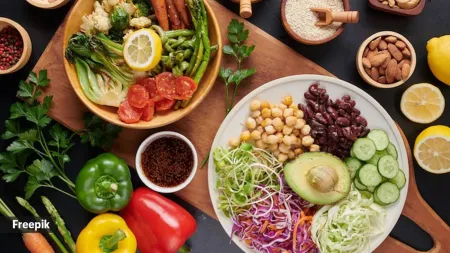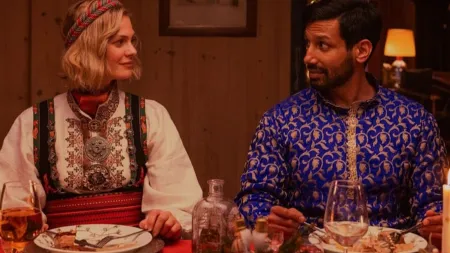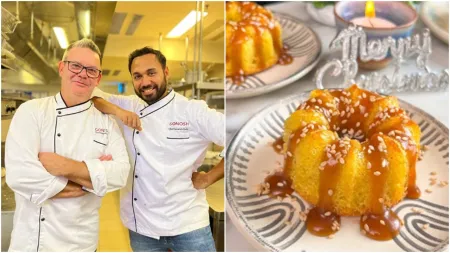‘Similar to how K-pop grabbed global attention, India has the potential to introduce a fresh, unique sound to the world’: Sneha Khanwalkar
She describes her music as a “fusion of diverse sounds”, and rightly so, as Sneha Khanwalkar is best known for her innovative compositions which include diverse songs like Kaala Rey, Laal Tamatar, to Nagri Nagri. By drawing inspiration from the “organic sounds in our surroundings”, the music composer and artist admits to creating “immersive musical experiences by incorporating elements from everyday life” — and, we admit, she does a super fine job at it.
However, we do not get to hear her music as much as we would like to. As such, when we learned about her recent collaboration — that goes beyond films and web series — we got excited and wanted to know all about it, along with her journey so far. And Sneha agreed! So, without further ado, dive deep and know more about her latest work, what music means to her, and her experience of composing for Star Wars: Vision and so much more. Read the edited excerpts below:

From Kal: Yesterday and Tomorrow to Gangs of Wasseypur (GoW) and various projects in between — how would you describe your journey?
“Absolutely de-licious and full of unexpected flavours” — is how I would put it! I’ve discovered many new musical tastes I wasn’t aware of before, adding a delightful twist to my sonic palate. This exploration has been an adventure, constantly seeking and discovering different sonic phases and sound palates. Each encounter brings a unique flavour, making this musical journey an incredibly enriching experience. Cheers to the diversity of sounds and the joy of discovering new musical dimensions.
When and how did your love affair with music begin?
I find inspiration in the things that make me happy. From savouring culinary delights to immersing myself in the captivating narratives of alternative animation films, from losing myself in the pages of a compelling book to venturing into the unknown through travel — these pursuits are not just pastimes but wellsprings of creativity. Music, for me, serves as the brushstroke that paints the canvas of my experiences. It is the tool through which I weave emotions and stories gathered from these diverse passions. A profound connection exists between my love affair with animation films and the melodies I compose. Through my compositions, I endeavour to translate a dance of flavours that resonate with the soul. Each note is a brushstroke of the joyous symphony created by the union of my cherished pursuits.
While you worked in many films before them, it would not be erroneous to say that you stepped into the limelight with Oye Lucky Lucky Oye, and then strengthened your presence with the Gangs of Wasseypur. What do you think you did differently that clicked with the masses at large?
Music is a bridge to connect with people. Immersing myself in diverse sounds for cinema, I aim to create and relate, understanding the narrative’s pulse and emotions. Oye Lucky Lucky Oye explored specific musical territories, and GoW helped me delve into intricate genres. Exploring genres consciously adds layers to the storytelling and helps me connect with the audience on a deeper, more personal level. Each project is a unique journey, exploring different musical realms to add layers to storytelling and connect with the audience personally. It’s about creating music that resonates with the hearts and experiences of those it reaches.
Similarly, how do you like to describe your music — and how do you justify that description?
I describe my music as a fusion of diverse sounds, drawing inspiration from the organic sounds in our surroundings. I strive to create authentic and immersive musical experiences by incorporating elements from everyday life. By embracing the richness of organic sounds, I aim to craft a distinctive and genuine musical journey that resonates with diverse audiences, diverging from the conventional norms of music.
View this post on Instagram
A post shared by Sneha Khanwalkar (@snekhanwalkar)
Not only films, you have also composed music for digital series. In what ways is the process and experience different?
Composing music for digital series brings different challenges and dynamics compared to films. The adrenaline is notably higher in OTT platforms due to steeper deadlines. Working on episodic content, as experienced with Tabbar, marked a new territory for me. The series format introduced a unique challenge, not only in terms of deadlines but also in the sheer volume of music required. The exhilaration came from the intensity of creating music for each episode, contributing to a cumulative total of eight hours of music across eight episodes. This format demanded a rapid approach, adding an exciting kick to the creative process. Navigating the digital series world has been a thrilling experience, marked by tight schedules and a wealth of musical storytelling to unfold.
Tell us about your collaborative composition with ‘Licious’. What is the most quintessential ‘Sneha Khanwalkar’ element in it?
Collaborating with ‘Licious’ on their ‘Decemmmber’ campaign has been a great experience since it combined my love for good food and music. The idea of starting celebrations in early December, rather than waiting, resonated with me. ‘Licious’ has truly embraced ‘Decemmmber’ with special offerings that make you go ‘mmmm’ as you enjoy their seasonal delights.
Creating the ‘Sound of the Season’ was about crafting a unique and experimental tune that captures the pure indulgence of this festive time. The music incorporates sounds shared by the brand’s fans nationwide, reflecting the joy of relishing their favourite meat and seafood. It’s not just about the melody; it’s about capturing the happiness that comes with enjoying these culinary delights.
View this post on Instagram
A post shared by Licious (@licious_foods)
Before films you did a show on sounds tripping. Do you think it would have been more successful (and probably even seen more seasons) had it been in the days of the social media & OTT?
The audience for ‘Sounds Trippin” was the curious minds of young individuals passionate about music and eager to explore its creation. The concept of a slightly older mentor travelling the country, engaging in a DIY approach to music-making, resonated particularly well with this demographic. These shows would later be live on platforms like YouTube, and their broad accessibility proved effective in reaching a wider audience, especially the younger demographic. The engagement with the audience was also notable, especially with young participants sharing their musical experiments, recording sounds from their daily lives, and finding inspiration in unconventional places.
In the current landscape dominated by OTT platforms, accessibility can be a limiting factor because the content is limited to the platform. This might have altered the dynamics, but the essence of simplifying music-making for young enthusiasts remains a timeless and valuable concept.
You have also composed the music for Stars Wars: Vision. Are you a fan of the universe? How was the experience?
The Star Wars universe has a timeless allure, and being part of it, even in a small way, has left me with so many memories on my creative journey. Having grown up watching shows like Small Wonder and becoming a recent fan of Rick and Morty, the transition to composing for Star Wars: Vision was a fascinating journey. The opportunity to collaborate with director Ishan Shukla and contribute to bringing an Indian perspective to the Star Wars universe was both challenging and rewarding. Understanding his vision for the project and infusing elements from Indian culture into the Star Wars narrative added a distinct flavour to the music. The prospect of working on an original Star Wars film is a dream I would eagerly embrace if given the chance.
How would you describe the reach and success of Indian music on the global scale?
Indian music, mainly Bollywood and Punjabi genres, have made a big impact globally. These styles are recognised as unique cultural experiences, even if people don’t actively listen to them. While Bollywood and Punjabi music have been India’s global musical ambassadors, there’s a lot more to explore. Similar to how K-pop emerged and grabbed global attention, India has the potential to introduce a fresh, unique sound to the world. The question of what the next globally popular music genre from India will be is interesting. India’s music heritage is rich, covering classical traditions, folk, regional sounds, and more. Exploring and innovating within these diverse musical realms could reveal the next wave of global musical influence from India. As the global music scene changes, Indian artists have a great opportunity to showcase the depth and diversity of their music, giving the world a more complete picture of India’s musical landscape.
What can we expect from you in the coming year?
In the coming year, you can anticipate new music coming out of our studios after a well-deserved sabbatical over the past couple of years. I’m thrilled to share that a project titled Schirkoa, an animation film produced in collaboration with French and German partners, is set to have its world premiere in Rotterdam in January. Additionally, I’m currently working on music for Anurag Kashyap’s upcoming project, Vikram Motwane’s next venture, and the sequel to LSD 2. It’s an exciting lineup, and I’m looking forward to bringing these diverse projects to life through music. Stay tuned for the musical journey ahead.
Disclaimer: The copyright of this article belongs to the original author. Reposting this article is solely for the purpose of information dissemination and does not constitute any investment advice. If there is any infringement, please contact us immediately. We will make corrections or deletions as necessary. Thank you.





